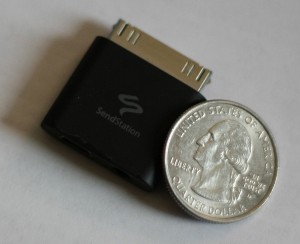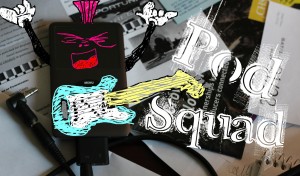By GABRIEL SALDAÑA
The bulk of music listeners, sadly, aren’t discerning when it comes to audio quality. These are people satisfied by listening to music through laptop speakers and prepackaged iPod earbuds. If that description applies to you, you’re done reading; head over to the “columns” section and check out She vs. He. The rest of this is for those who want better sound for relatively little money.
You may have noticed that when you use your iPod’s headphone jack to connect to an auxiliary input — like the little jack in your car or the RCA input behind your stereo receiver — you have to turn the iPod volume way up and you have to turn the stereo’s volume way up. If you appreciate good sound, you’ve also noticed that, while you manage to force out some volume, this method makes your music muddy, noisy and less robust.
Fortunately, there is a different way to plug in your iPod that will enhance your listening experience: connect in a way that employs what’s called a line-level signal. When you use a line-level signal, the volume coming out of your player stays at a constant so you only adjust the sound on your receiver, which is probably a car stereo for most of you. The volume control on your iPod will be rendered useless so you can turn it all the way down, which will extend your player’s battery life. The sound that comes through your speakers once you connect via line-level will be much clearer and more robust. You also won’t have to max out your stereo’s volume to hear it well.
How to make a line-level connection:

A line-level signal can be easily coaxed out of your iPod’s dock connection by using any number of connectors made specifically for that task. Those will send sound through the dock connection (instead of the headphone jack) directly to auxiliary inputs like the ones in cars. A line-level connector will basically add what looks like a mini male or female headphone jack to the bottom of your iPod (see photos.) You’d connect that to your stereo the same way you would a headphone jack. But the sound that comes out of the line-level jack will be much better.
The line-level connector I use on my iPod is the SendStation PocketDock. It costs about $30 and is about the size of a quarter (see photos.) Aside from extracting a great-sounding line-level signal from my iPod, the PocketDock allows me to charge the battery and play music at the same time, all from my player’s dock connection. It also lets me connect my iPod to the computer with a regular ol’ mini USB cable, eliminating the need to buy any more proprietary Apple cables if I happen to lose the one that came with my player. The PocketDock is available at www.sendstation.com. Search “iPod line-out cable” online to find line-level connectors other than the one I’ve suggested. As a precaution, don’t pay more than $30 for one of these. Many can be had for as little as $5 as long as you don’t care about charging while listening or USB connectivity. Some vendors will charge as much as $100 saying their line-level cables are gold plated and that they use special wire. What they won’t tell you is that none of those features make a bit of difference.
Side note: Buying a line-level connector is not the same as buying a portable player with an iPod dock. Those sound like garbage. A line-out connection lets you connect your iPod to ANY receiver with line-in capability.

How line-level signals make better sound:
If all you wanted to know was how to achieve better sound and you don’t really care about how or why that sound is achieved, you’re done reading. Head over to the “music” section to pick out a show to attend next month.
For the rest of you, to understand why line-level signals sound better, you need a VERY basic understanding of two things: ohms and volts. Ohm (Ω) is a measurement of current impedance. Since it impedes the flow of electrons, the more ohms you have in a circuit, the smaller the electron current flowing through it. A volt (V) measures the force that causes electrons to flow (audio signal.)
The iPod is putting out about 2.5 V from its headphone jack at full volume and just slightly more volts from the line-level output. Most component products’ line-levels put out 5V to 6V. There’s nothing you can do for the iPod to remedy its low voltage without an external amplifier. But volts aren’t what make the iPod’s line-level sound better than its headphone jack in this case. The difference between the two here is that the line-level’s signal is noise-free and clean because it doesn’t pass through the iPod’s crappy amplifier. That crappy amplifier adds unsavory extras (especially at higher volumes) instead of allowing the music to come across flat and true to the recording. That’s why it’s best for music not to have to go through it.
Ohms also play a role in making the line-out sound better than the headphone jack.
A headphone jack is usually set around 25 Ω -150 Ω for headphones. But the line-level input on a full-size stereo receiver and its output component (like a component CD or DVD player) can be rated much higher, even as high as 15,000 Ω. The line-level on the iPod uses a higher ohm rating, which better matches the higher ratings on larger receivers. Because of that match, more of the signal (V) is accurately transferred between the iPod and the receiver via a line-level connection.
There you have it; thanks for reading.


































The symbol for ohms turned into Xs once I posted. I do know it’s the omega fyi.
this was very informative…so it’s best to use the bottom of the ipod than the top…got it.
On the SendStation PocketDock, I assume the USB port bypasses the ipods DAC and sends out a digital stream only. Is that right? So you go from your ipod into an external DAC then into your sound system preamp or amp?
@RIck. The PocketDock does not bypass the internal DAC but takes the signal directly from it and bypasses the internal amp for a cleaner sound. So you go directly from the PocketDock to you pre or power amp, no external DAC necessary.